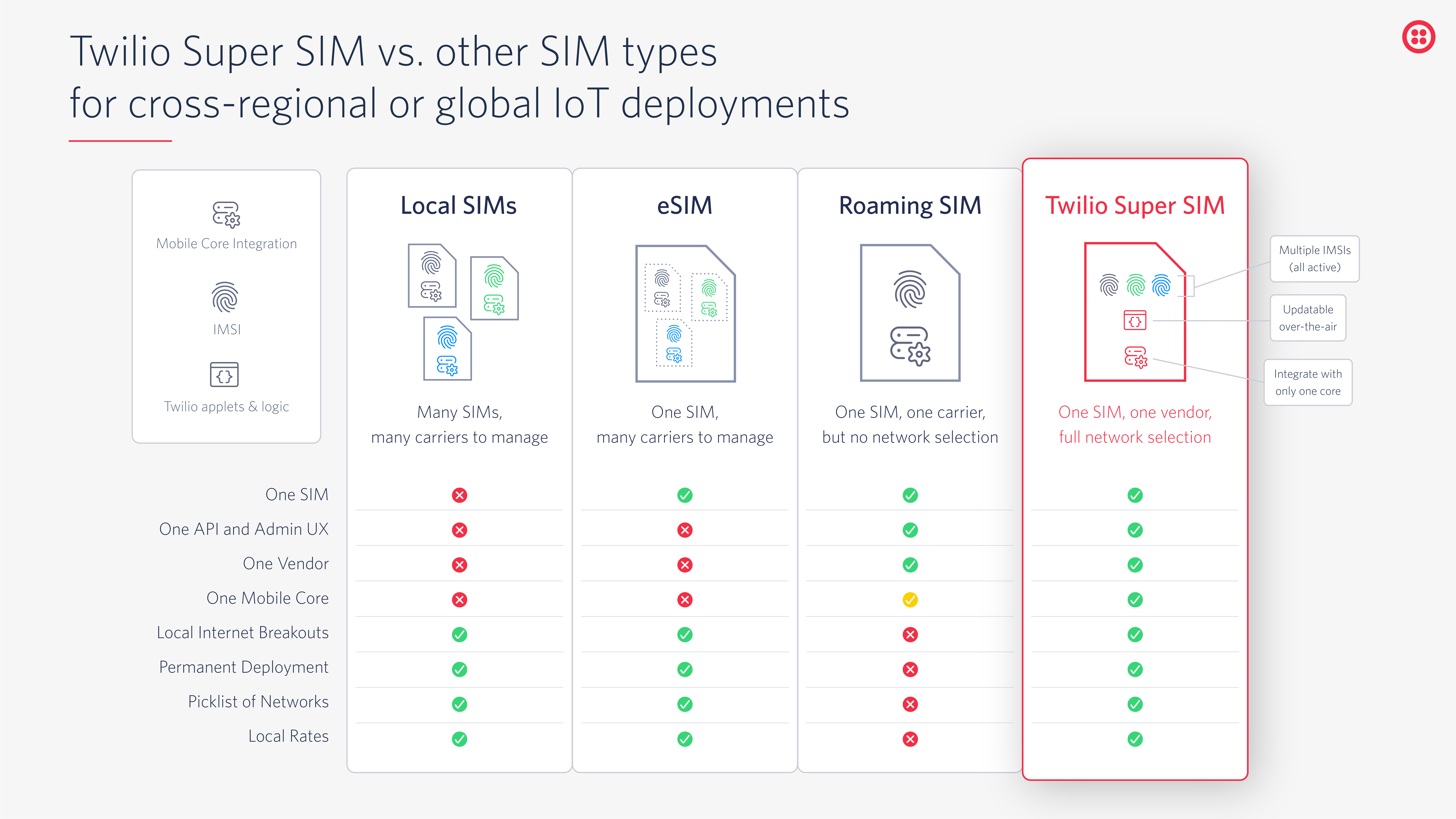How to Pave the Way to Manageable Global IoT Deployments with Multi-IMSI SIMs
Time to read: 8 minutes

Did you know that many IoT projects either don’t reach their ROIs as quickly as intended or fail altogether? In fact, only 26% of companies have had an initiative that they considered a complete success and 60% of initiatives don’t even make it past the Proof of Concept stage. Complexity is to blame—complexity stemming from the need to tackle many different layers of technology for a successful IoT deployment, but also complexity within layers such as connectivity itself. This article introduces the cellular complexity challenge, and shows ways to address it.
The cellular complexity challenge
We applaud the availability of cellular networks around the globe, but behind each network are individual carriers, which are commercial businesses in most cases; interoperability, openness, or accessibility are not their top concerns, but it is those attributes that anyone planning to deploy across borders would require for a global implementation that remains manageable and maintainable.
IoT product managers would rather:
- Deploy globally with a single connectivity provider and not worry about striking deals with local mobile network operators (MNO) in each country
- Get consistent network behavior (NAT, firewalls, radio types) irrespective of where they deploy their devices
- Have control over which network each of their devices use per country
- Operate a single connectivity management platform to manage all of their SIMs in a centralized way
The drawbacks of roaming SIMs and eSIMs for IoT deployments
For a while, roaming SIMs seem to have fit the bill: go with a large carrier in your “home” country and leverage their roaming partnerships outside of their borders to get international connectivity. It quickly became apparent, though, that this comes with its own problems: the roaming networks your devices will be “put on” might not actually be compatible with your hardware, but you have no say in what those networks are. And within your home country, you will only get the network of your home carrier, unless you equip your device with a second or more physical SIMs – which defeats the idea of getting a “manageable and maintainable” deployments, as product SKUs multiply.
In recent years, a technology is emerging that at the surface seems to resolve the above concerns: eSIM / eUICC – the GSMA standard that allows the cloud-based loading and activating of SIM profiles over-the-air on a standard piece of hardware, without needing to deal with swapping physical SIM cards anymore whenever a provider change is necessary; be it to get connectivity in new regions, better commercial conditions, or better technical support from a different provider serving the same region.
eSIM, however, doesn’t actually solve any of the concerns reliably, and adds other problems into the mix. Before diving into why eSIM is not the best way forward for cellular IoT, let us first introduce the approach that is: Multi-IMSI SIMs. An IMSI is an identifier for which carrier you’re with and is essentially the key that lets you onto a specific network. Normally, a SIM holds exactly one IMSI. Multi-IMSI SIMs, however – you guessed it – come pre-equipped with multiple of these identities. Furthermore, if done right, these SIMs can automatically switch IMSIs based on where your device is located and provide an IoT fleet with connectivity through the best set of networks and radio technologies in each country.
Now that we’ve laid the groundwork, it’s time to take a deeper dive into what an IMSI is, why it is relevant for your IoT device, and what it means to have multiple IMSIs.
What is an IMSI?
IMSI stands for International Mobile Subscriber Identity and uniquely identifies a cellular subscriber. The first 6 digits of the IMSI represent the MCC (Mobile Country Code) and MNC (Mobile Network Code). The MCC + MNC combination helps any network quickly identify which home network you belong to.
For example, if you are an AT&T subscriber in the US and roaming in the UK, the MCC in your SIM would be set to 310 (“United States”) and the MNC would be set to 410 (“AT&T”). When you attach to a local network in the UK, such as O2, then that provider O2 would look at the MCC + MNC combination and would immediately know that you are an AT&T subscriber. O2 would then contact AT&T’s so-called Mobile Core to authenticate and authorize you and give you cellular access. Mobile Cores are the key part of any wireless network that control who may connect, and how data flows from devices to networks such as the Internet.
The rest of the (9 or 10) digits in the IMSI uniquely identify your subscription within the Mobile Network Operator (MNO).
Single-IMSI SIMs
Each SIM typically has one IMSI and one set of secret keys that represents a cellular subscription profile. When you get a SIM from a traditional mobile network operator (MNO), you get a SIM with a single subscription profile on it, with the subscription profile identified by the IMSI.

When you deploy in a single country, a single IMSI SIM from an MNO is a viable solution in most cases. But when the MNO does not have good coverage throughout the country or has outages, then it becomes less than an ideal solution.
Deploying globally with single-IMSI SIMs
When you want to deploy in multiple countries with single IMSI SIMs, you have two options:
Regional relationships
You negotiate deals with multiple MNOs and end up with one SIM per MNO.
There are a number of disadvantages with this approach:
- You have to use multiple SKUs for the SIMs, which complicates the manageability of your solution. Your device must be installed with a specific SIM depending on which country it is going to be deployed in
- You have to integrate with multiple connectivity management platforms (be they programmatic APIs, or Web Consoles for operational staff)
- Your application/device software has to deal with different network characteristics and adapt to the network behavior. For example, MNO #1 could have a UDP NAT timer of 60 seconds whereas MNO #2 could have a UDP NAT timer of 300 seconds. Your applications would need to behave differently to deal with these nuanced differences.
Global roaming with a single MNO
Another option to deploy globally is to use a single IMSI SIM from one MNO and leverage the roaming relationships of that MNO.
As briefly touched upon before, there are again a number of disadvantages with this approach:
- There is typically just one network available in each country through the MNO roaming relationships. You won’t have a fallback when the only available network in a specific country has poor coverage or an outage.
- You may be subject to a practice that’s called network steering: your home provider you have the contract with might force your devices to stop using one network and switch to another network in a specific country, without taking into account your device capabilities or your preferences. This might lead to actual loss of connectivity.
- You will likely experience high latency, since the traffic from each device has to go through the MNO’s mobile core in a specific country. For example, if you deploy in Australia with a SIM from an MNO in the US, the traffic between your device and your application cloud will always be routed with a mobile core in the US, resulting in high round trip times.
What is a Multi-IMSI SIM?
A multi-IMSI SIM is a significant departure from the traditional single-IMSI SIMs. Multi-IMSI SIMs can store multiple IMSIs and switch them based on where a device is located.
Whenever your device boots up, the cellular modem scans for available networks and reports the location of the device as a country code to the SIM. The SIM already has pre-configured information that lets it pick the IMSI that provides the best set of networks in that country and responds with an IMSI to use. Your device then uses that IMSI to register with a visited cellular network to gain access to the Internet and reach your application cloud. The interaction between the cellular modem and the SIM is based on GSMA standards, which makes it easy to use multi-IMSI SIMs with a variety of cellular modems.
The IMSI switching logic is local to the SIM; the SIM does not need to talk to the connectivity provider’s backend to determine which IMSI to use. This makes it an ideal solution to use when your device moves between countries and boots up in a new country, or you manufacture your devices centrally and then send them to their deployment location afterwards.
Multi-IMSI SIM versus eSIM / eUICC SIM
Now let’s revisit the eSIM idea sketched earlier. Using eSIM / eUICC SIMs is another approach to solving the problem of deploying globally with a single SIM. The idea here is that you would install a specific SIM in your device that adheres to the GSMA “eUICC” standard and then download different SIM profiles as required, depending on where your device is located. An eSIM can hold multiple SIM profiles as dormant profiles, but activate only one.
Each SIM profile on the eUICC SIM represents one subscription to an MNO.
While this appears as a viable solution to the complexity challenge at first glance, there are a number of issues:
- There are still multiple SIM profiles stored on the eUICC SIM. Each SIM profile corresponds to a subscription to a specific MNO. This leads to a situation where you still have to use multiple connectivity management platforms and integrate against multiple mobile cores with different network characteristics.
- The out-of-box experience is not great if you have to download a SIM profile when the device is booted up for the first time in a different country.
- If you choose an approach where you have multiple SIM profiles stored on the SIM, you will likely end up paying for each SIM profile, even when they are not being used. Only one SIM profile can be active at any time, so other SIM profiles are present on the SIM as backup SIM profiles, but at the same time incurring costs.
It should be apparent by now that multi-IMSI SIMs have clear advantages over eSIM SIMs, and finally help address the cellular complexity challenge. Case in point: micro-mobility leader Lime needed a simple solution for their fast-paced growth of deploying e-scooters in more and more countries. Their manufacturing is in China, and going with a multi-IMSI solution allowed them to not worry about connectivity at all when shipping their devices to over 100 cities around the world.
If you need a simple solution to getting reliable global cellular connectivity, multi-IMSI SIMs are your best option.
Twilio Super SIM is a multi-IMSI SIM with automatic failover built-in
Twilio Super SIM® is a multi-IMSI SIM that enables a true “One SIM, One API, Deploy everywhere” solution. Each Super SIM comes with multiple IMSIs and sophisticated IMSI switching logic built into the SIM.

Besides picking the right IMSI to use, each Twilio Super SIM also provides a backup IMSI for each country in case the primary one for that country has a network issue or an outage. When the primary IMSI for a specific country has an issue and the device cannot get online, the cellular modem in the device reports degraded service to the SIM. The SIM then switches to a backup IMSI and tells the cellular modem to use the backup IMSI. This switching happens automatically without manual intervention or without requiring to talk to a backend system.
By having a single SIM profile with multiple IMSIs on the SIM and switching IMSIs automatically using software, Twilio Super SIM also avoids the issues outlined in the previous section on eSIM.
Here's the good news: When it comes to multi-IMSI and eSIM / eUICC, it is not an either-or decision. You may want to use an eUICC SIM to decouple your devices from the connectivity provider and switch providers when needed without a costly IMSI swap. In this case, you can download Super SIMs into your eUICC SIMs as eSIM profiles. With a Super SIM profile installed on your eSIM, you get the ability to deploy globally with a single SIM with the flexibility to switch between the Twilio Super SIM profile and another connectivity provider’s profile whenever you want. The main benefit from eSIM, not being tied to a single connectivity partner, is still preserved.
Related Posts
Related Resources
Twilio Docs
From APIs to SDKs to sample apps
API reference documentation, SDKs, helper libraries, quickstarts, and tutorials for your language and platform.
Resource Center
The latest ebooks, industry reports, and webinars
Learn from customer engagement experts to improve your own communication.
Ahoy
Twilio's developer community hub
Best practices, code samples, and inspiration to build communications and digital engagement experiences.


